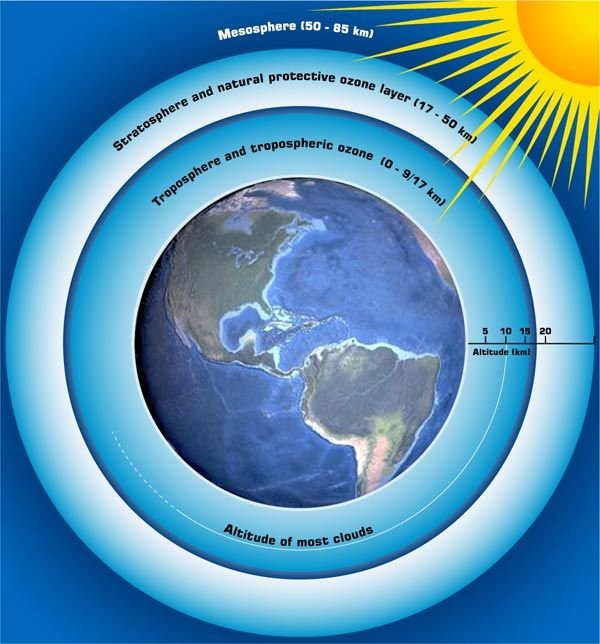Our Earth has an atmosphere that we can call the air sphere, which many planets do not have. Atmosphere is the gas layer that surrounds the Earth, where various gases are found in the formation we call it. The atmosphere is quite big for the creatures, the daytime makes the earth cooler and the nights warmer.
Benefits of Atmospheric
** Organizes climatic events and provides the necessary gases for living things.
** It keeps harmful rays from the sun through the layers and helps to break up the meteors.
** It prevents the earth from overheating and cooling.
** It prevents the burning that may be born without friction by turning with the earth.
** Provides illumination of the shadows by distributing the rays from the sun.
** Provides transmission of sound, voice and temperature.
There are some features that this gas layer has. Approximately 78% of the atmospheric gases form nitrogen and 21% form oxygen. The remaining 1% is composed of various gases such as carbon dioxide, neon, helium, hydrogen.

Some of the gases that make up the atmosphere are constantly constant, and some of them are composed of gases that can change. Gases that are fixed in quantity are constantly present in the atmosphere and their quantities do not change. The most common of the unchanging gases are nitrogen and oxygen gases. On the other side are the pollutants which can be changed by the influence of the environmental conditions, as well as carbon dioxide, water vapor and ozone gases.
Layers of Atmosphere
--
Because many gases in the atmosphere are different from each other, gases that are lighter by the effect of gravity cause gases that are heavier above and layers below the atmosphere by staying lower.
Troposphere
The atmosphere is the layer that comes into contact with the earth and is located under the other Layers. The troposphere contains much of the gases in the atmosphere than other layers. 75% of the gases in the atmosphere and all of the water vapor present in the atmosphere are present in this layer. Due to this reason, almost all of the events such as rainfall, humidity, meteorological events, air movement occur in this layer. Because the troposphere is warmed by sunlight reflected from the ground, the lower layers are warmer and the temperature decreases by about 1 ° C every 200 meters.

The thickness of the troposphere can show different thicknesses in different locations due to the geoit shape of the earth. As can be guessed, the thickest point is on the equator and can vary between 16-17 km. The thinnest region is also in the poles and its thickness ranges from 9 to 10 km.
Stratosphere
Since it is a layer about 50 km thick from the troposphere and does not contain water vapor, vertical air movements are not seen, only horizontal air movements are seen. This layer can sometimes create risky situations. Some pollutant gases and dust clouds reaching this layer do not have vertical air movements, so only with the effect of horizontal air movements, they become constantly circulating in the layer, which can sometimes lead to long-term air pollution.
The temperature of this layer is constant and is -45 ° C. The objects lose their weight on earth because of the decrease in the amount of gravity towards the upper parts of the stratosphere.
Mesosphere
This stratum that comes after the stratosphere can reach up to 80 km thickness from the Stratosphere. Many celestial rocks crumble in this layer under the influence of friction. Ozonosphere and Kemosfer are two layers;

The ozone layer contains ozone gas. The harmful rays from the sun are kept by ozone gases, preventing the living things on the earth from being damaged. The Kemosfer layer is where the gases start to ionize.
Thermosphere
This layer, which can reach 400 km thickness from the Mesosphere, can be intensely felt by the sun rays. In this layer, gasses are in the form of ions and the electron exchange between the ions is quite high. This makes it possible to transmit radio waves and communication signals very well in this layer.
Exosphere
The exosphere layer is considered to be the topmost layer of the atmosphere and its upper limit is unknown to the precise limit, and it is assumed that its upper limit is 10,000 km above the ground. This layer is composed of a small amount of helium and hydrogen atoms. Because the gravity is very low, the gases here are also very steady. Artificial satellites are also found in this layer.
Congratulations @diamondcase! You have completed some achievement on Steemit and have been rewarded with new badge(s) :
Click on any badge to view your own Board of Honor on SteemitBoard.
To support your work, I also upvoted your post!
For more information about SteemitBoard, click here
If you no longer want to receive notifications, reply to this comment with the word
STOPVery nice article you have there! But do not forget to cite your sources and credit your images when necessary